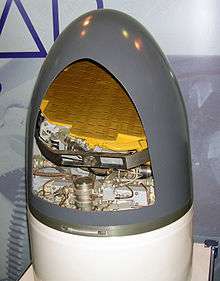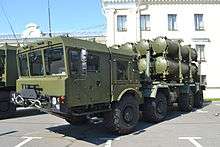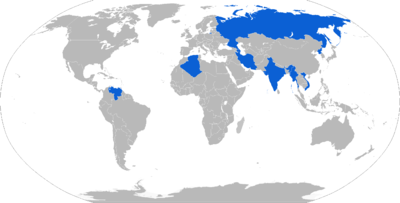Kh-35
| Kh-35 (NATO reporting name: AS-20 'Kayak') 3M24 Uran (SS-N-25 'Switchblade') 3K60 Bal (SSC-6 'Sennight') | |
|---|---|
|
Kh-35E in MAKS-2009 | |
| Type | air-to-surface, surface-to-surface missile |
| Place of origin | Soviet Union |
| Service history | |
| In service | 2003 |
| Used by |
Russian Navy Indian Navy Vietnamese People's Navy |
| Production history | |
| Designer | Zvezda |
| Designed | 1983-2003 |
| Manufacturer | Tactical Missiles Corporation |
| Unit cost | $500,000 (2010)[1] |
| Produced | 1996 for export, 2003 for Russia |
| Specifications | |
| Weight |
520 kg (1,150 lb)[2] 610 kg (1,340 lb)[2] (heli version) |
| Length |
385 cm (152 in)[2] 440 cm (173 in)[2] (heli version) |
| Diameter | 42.0 cm (16.5 in)[2] |
| Warhead | HE shaped charge |
| Warhead weight | 145 kg (320 lb)[2] |
|
| |
| Engine |
turbofan 450 kgf |
| Wingspan | 133 cm (52.4 in)[2] |
| Propellant | kerosene |
Operational range |
130 km (70 nmi) 300 km (160 nmi) (2015)[3] |
| Flight altitude | 10-15 m en route and about 4 m at terminal area |
| Speed | Mach 0.8 (609 mph; 980 km/h) |
Guidance system | inertial guidance and ARGS-35E X-band terminal active radar homing[4] |
Launch platform | Su-24, MiG-29M/K, Su-27SM, Su-30MKI, Su-34, HAL Tejas, Ka-27, Ka-28,[2] also ships and boats, coastal, LACM, TEL variants. |
The Zvezda Kh-35U ('Star', Russian: Х-35У, AS-20 'Kayak') is the jet-launched version of a Russian subsonic anti-ship missile. The same missile can also be launched from helicopters, surface ships and coastal defence batteries with the help of a rocket booster, in which case it is known as Uran ('Uranus', SS-N-25 'Switchblade', GRAU 3M24 ) or Bal ('Ball', SSC-6 'Sennight', GRAU 3K60). It is also nicknamed "Harpoonski", because it looks like and functions very similar to the American Harpoon Anti-Ship missile. It is designed to attack vessels up to 5000 tonnes.[2]
Development
Zvezda started work on the Kh-35 in 1983 by a decree of the USSR Council of Ministers and the USSR CPSU Central Committee to arm ships of medium tonnage.
Design


The Kh-35 missile is a subsonic weapon featuring a normal aerodynamic configuration with cruciform wings and fins[2] and a semisubmerged air duct intake. The propulsion unit is a turbofan engine.[2] The missile is guided to its target at the final leg of the trajectory by commands fed from the active radar homing head and the radio altimeter.[2]
Target designation data can be introduced into the missile from the launch aircraft or ship or external sources. Flight mission data is inserted into the missile control system after input of target coordinates. An inertial system controls the missile in flight, stabilizes it at an assigned altitude and brings it to a target location area. At a certain target range, the homing head is switched on to search for, lock on and track the target. The inertial control system then turns the missile toward the target and changes its flight altitude to an extremely low one. At this altitude, the missile continues the process of homing by the data fed from the homing head and the inertial control system until a hit is obtained.
The Kh-35 can be employed in fair and adverse weather conditions at sea states up to 5-6, by day and night, under enemy fire and electronic countermeasures. Its aerodynamic configuration is optimized for high subsonic-speed sea-skimming flight to ensure stealthy characteristics of the missile. The missile has low signatures thanks to its small dimensions, sea-skimming capability and a special guidance algorithm ensuring highly secure operational modes of the active radar seeker.
Its ARGS-35E active radar seeker operates in both single-and-multiple missile launch modes, acquiring and locking on targets at a maximum range of up to 20 km.[5] A new radar seeker, Gran-KE have been developed by SPE Radar MMS[6] and will be replacing the existing ARGS-35E X band seeker.[7]
| [5][8] | Kh-35 | Kh-35U |
|---|---|---|
| Length: Ship/Land/Heliborne Aircraft |
3.85 m (12.6 ft) | |
| Diameter | ||
| Wingspan | ||
| Weight: Ship/Land-based Aircraft Heliborne |
620 kg (1,370 lb) 520 kg (1,150 lb) 610 kg (1,340 lb) |
670 kg (1,480 lb) 550 kg (1,210 lb) 650 kg (1,430 lb) |
| Guidance | Inertial, active radar | Inertial, satellite navigation, active/passive radar |
| Range | 130 km (81 mi; 70 nmi) | 7–260 km (4–162 mi; 4–140 nmi) |
| Seeker range | 20 km (12 mi; 11 nmi) | 50 km (31 mi; 27 nmi) |
| Speed | Mach 0.8 (609 mph; 980 km/h) | Mach 0.8–Mach 0.85 (609–647 mph; 980–1,041 km/h) |
| Cruising altitude Terminal altitude |
4 m | |
| Warhead | 145 kg (320 lb) HE penetrator | 145 kg (320 lb) penetrating HE frag |
Operational history
The Kh-35 missile entered service in 2003. In July 2003, the system created by the "Tactical Missiles Corporation" successfully passed the state tests and began to come into service of ships of the Russian Navy. Today it is generally accepted that in the criterion of "cost-effectiveness", "Uran-E" is one of the best systems in the world.[9] It has also been acquired by India.[10] The Bal coastal missile system in the fall of 2004 showed excellent results in the state tests and entered service in 2008.[11] From 2001-2015, Russia supplied Vietnam with 198 Kh-35E missiles for sea-based use. By June 2016, Vietnam was planning to start serial production of their indigenous KCT-15 anti-ship missile based on the Kh-35E, covering three types of Kh-35E missiles for sea-launched, air-launched, and coastal defense as part of the 3K60 Bal/SSC-6 Sennight mobile coastal defense system.[12]
Variants

- Kh-35 (3M-24) - Base naval version for Russia (2003).[5]
- Kh-35E (3M-24E) - Export version of Kh-35 (1996).
- Kh-35U - Base upgrade unified missile (can be used with any carrier), version for Russia in production (as of July 1, 2015).[8][13]
- Kh-35UE - Export version of Kh-35U, in production.
- Kh-35V - Version for Russia, launched from a helicopter.
- 3M-24EMV - Export version of Kh-35 missile-target without warhead for Vietnam.
- Kh-35 Uran/Uran-E (SS-N-25 'Switchblade', 3M-24) - Shipborne equipment of the control system with a missile Kh-35/Kh-35E.[14]
- Bal/Bal-E - Coastal (SSC-6 Sennight) missile complex with Kh-35/Kh-35E missiles (2008).
- KN-09 - Reported North Korean copy of the Kh-35U.
- Kh-37 or Kh-39 - possible name for nuclear-tipped variant.
- KCT-15 - License-produced Kh-35E by Vietnam.[12]
Operators

Current operators
 Algeria
Algeria Azerbaijan - Bal Coastal missile complex being delivered
Azerbaijan - Bal Coastal missile complex being delivered India
India Iran
Iran Russia - 112 Kh-35 (3M-24) delivered in 2009-2010.[15]
Russia - 112 Kh-35 (3M-24) delivered in 2009-2010.[15]
- The Russian Navy is composed of 4 (16 mobile launch systems) divisions already have a missile complex called "Bal" as of October 2015:[16]
- 1st Division is part of the 11th BSF Brigade Utash, Krasnodar
- 2nd Division—46th separate division of Caspian Flotilla, Dagestan
- 3rd Division is part of the 15th Black Sea Fleet Brigade Sevastopol, Crimea
- 4th Division in the 72nd PF Regiment Smolyaninovo, Primorsky Krai.
- At least one more complex was delivered to the Western Military District in the middle-2016.[17]
 Venezuela - Bal Coastal missile complex being delivered.
Venezuela - Bal Coastal missile complex being delivered.  Vietnam
Vietnam Myanmar Navy
Myanmar Navy North Korea - KN-09/Kh-35U surface to surface.
North Korea - KN-09/Kh-35U surface to surface.
Similar weapons
- Harpoon (missile) (USA) - 221 kg warhead, 93–315 km range depending on platform
- C-802 (China) - 165 kg warhead, 120–180 km range
- Exocet (France) - 165 kg warhead, 180 km range
- RBS-15 (Sweden) - 200 kg warhead, 200 km range
- Sea Eagle (UK) - 230 kg warhead, 110+ km range
- Type 80 Air-to-Ship Missile
- Type 88 Surface-to-Ship Missile
- Type 90 Ship-to-Ship Missile
- Type 93 Air-to-Ship Missile
- XASM-3
Notes and references
- ↑ annual report Tactical Missiles Corporation 2010.p. 92
- 1 2 3 4 5 6 7 8 9 10 11 12 Rosoboronexport Air Force Department and Media & PR Service, AEROSPACE SYSTEMS export catalogue (PDF), Rosoboronexport State Corporation, p. 123
- ↑ "Новая ракета X-35: гроза американских эсминцев". Retrieved 8 October 2015.
- ↑ https://web.archive.org/web/20120402214415/http://articles.janes.com/articles/Janes-Radar-and-Electronic-Warfare-Systems/ARGS-35E-Algeria.html. Archived from the original on April 2, 2012. Retrieved August 28, 2011. Missing or empty
|title=(help) - 1 2 3 "Tactical Missiles Corporation JSC Kh-35E". Retrieved 8 October 2015.
- ↑ http://www.radar-mms.com/catalog/args35/
- ↑ "Russia: JSC Tactical Missile Arms Presents New Target Seeker". Naval Today. Retrieved 23 December 2014.
- 1 2 "Tactical Missiles Corporation JSC Kh-35UE". Retrieved 23 December 2014.
- ↑ ""Уран-Э": рождение конструкторского замысла". Retrieved 23 December 2014.
- ↑ "Kh-37", Jane's Air-Launched Weapons, 2008-08-01
- ↑ "/". Retrieved 23 December 2014.
- ↑ "ТАСС: Армия и ОПК - "Тактическое ракетное вооружение" за три года запустило в серию 14 видов ракет". ТАСС. Retrieved 8 October 2015.
- ↑ http://www.granit-electron.ru/products/mil/complex/uran/index.shtml
- ↑ Annual report Tactical Missiles Corporation 2010.p. 92
- ↑ "Береговой ракетный комплекс "Бал" поступил на Тихоокеанский флот". Retrieved 8 October 2015.
- ↑ http://tass.com/defense/907916
